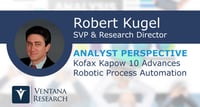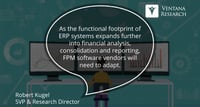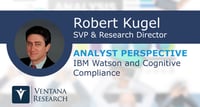Price and revenue optimization (PRO) is a business discipline used to produce demand-based pricing; it applies market segmentation techniques to achieve strategic objectives such as increased profitability or greater market share. In essence, PRO enables companies to surf the demand curve using dynamic rather than fixed pricing to achieve the most desirable trade-offs between revenue volume and profit margins. The trade-off is defined by strategic factors such as the company’s market position,...
Read More
Topics:
Big Data,
Data Science,
Sales,
Office of Finance,
Analytics,
Cloud Computing,
Sales Performance Management,
Financial Performance Management,
Price and Revenue Management,
Pricing and Promotion Management,
Sales Enablement and Execution,
ERP and Continuous Accounting
Kofax offers Kapow, robotic process automation (RPA) software used to acquire information from a range of sources without human intervention and without having to write code. These sources include websites, applications, unstructured documents, data stores and desktop spreadsheets. RPA software does repetitive, low-value work that otherwise may be performed by person. It saves time in these tasks, completing them sooner and freeing skilled individuals to concentrate on work that utilizes their...
Read More
Topics:
Office of Finance,
Operations,
close,
finance,
banking,
Digital Technology
Ventana Research defines financial performance management (FPM) as the process of addressing often overlapping issues involving people, process, information and technology that affect how well finance organizations operate and support the activities of the rest of their organization. FPM software supports and automates the full cycle of finance department activities, which include planning and budgeting, analysis, assessment and review, closing and consolidation, internal financial reporting...
Read More
Topics:
Performance Management,
ERP,
FP&A,
Human Capital Management,
Office of Finance,
Consolidation,
Financial Performance Management,
FPM
The treasury function in finance departments doesn’t get a lot of attention, but it’s a fundamentally important one: to ensure that all funds are accounted for and that there is sufficient cash on hand each day to meet operating requirements. Keeping track of and managing cash, especially in larger organizations, can be complicated because of multiple bank accounts, complex financing requirements and various methods of receiving and making payments; the complexity deepens when more than one...
Read More
Topics:
Predictive Analytics,
Office of Finance,
credit,
debt,
Analytics,
CFO,
cash management,
controller,
Financial Performance Management
Ventana Research awarded our Governance, Risk and Compliance (GRC) Business Innovation Award for 2016 to IBM for IBM Regulatory Compliance Analytics, powered by Watson (IRCA). This application of cognitive analytics is designed to streamline the identification of potential regulatory requirements and suggest methods for compliance. In so doing the cloud-based system can cut the time and cost of compliance while creating an effective means of ongoing management and control of compliance...
Read More
Topics:
GRC,
Machine Learning,
Office of Finance,
Dodd-Frank,
Risk Analytics,
compliance,
finance,
Financial Services,
Watson,
IBM Regulatory Compliance Analytics















